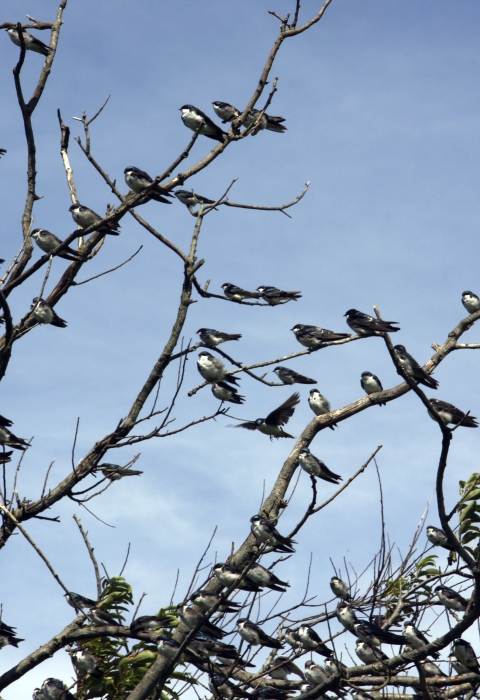About Us
Welcome to Sachuest Point National Wildlife Refuge! This refuge is one of five National Wildlife Refuges in Rhode Island managed by the U.S. Fish and Wildlife Service. There are over 570 National Wildlife Refuges in the United States and its territories, and our mission is working with others to conserve, protect, and enhance fish, wildlife, plants, and their habitats for the continuing benefit of people like yourselves. Sachuest Point is one of the few remaining undeveloped coastal properties in Rhode Island and is specifically managed for migratory species like the piping plover, saltmarsh sparrow, snowy owl, harlequin duck, and monarch butterfly. Managing for migratory species means that we provide habitat for these species and more to rest, forage, and breed. For example, we plant milkweed for the monarch butterflies, and protect nesting areas for shorebirds on the local beaches. We also remove invasive species invasive species
An invasive species is any plant or animal that has spread or been introduced into a new area where they are, or could, cause harm to the environment, economy, or human, animal, or plant health. Their unwelcome presence can destroy ecosystems and cost millions of dollars.
Learn more about invasive species through a variety of management methods.
Each year, our trails attract more than 320,000 visitors who enjoy activities such as photography, wildlife observation, fishing, and more. Nothing that we do could be done without the support of our partners and volunteers!
Our Mission
Refuge Complex Vision
We developed this vision statement to provide a guiding philosophy and sense of purpose for the five refuge Comprehensive Conervation Plans. It qualitatively describes the desired future character of the Refuge Complex through 2015 and beyond. We wrote in the present tense to provide a more motivating, positive, and compelling statement of purpose. It has guided, and will continue to guide, program emphases and priorities for each refuge in Rhode Island.
“The Rhode Island National Wildlife Refuge Complex protects a unique collection of thriving coastal sandplain, coastal maritime, and beach strand communities, and represents some of the last undeveloped seacoast in southern New England. Leading the way in the protection and restoration of coastal wetlands, shrubland, and grassland habitats, the Refuge Complex contributes to the longterm conservation of migratory and resident native wildlife populations, and the recovery of endangered and threatened species. These refuges offer research opportunities and provide an outstanding showcase of habitat management for other landowners.”
“The Refuge Complex is the premiere destination for visitors to coastal Rhode Island to engage in high quality, wildlife-dependent recreation. Hundreds of thousands of visitors are rewarded each year with inspiring vistas and exceptional opportunities to view wildlife in native habitats. Innovative environmental educational and interpretive programs motivate visitors to become better stewards of coastal resources.”
“Through partnerships and extensive outreach efforts, Refuge Complex staff are committed to accomplishing refuge goals and significantly contributing to the Mission of the National Wildlife Refuge System . This commitment will strengthen with the future, revitalizing the southern New England ecosystem for generations to come.”
Refuge Purpose
Each unit of the National Wildlife Refuge System is established to serve a statutory purpose that targets the conservation of native species dependent on its lands and waters. All activities on those acres are reviewed for compatibility with this statutory purpose.
The purpose(s) of Sachuest Point National Wildlife Refuge are:
“... for the development, management, advancement, conservation, and protection of fish and wildlife resources,” and for “(1) incidental fish and wildlife oriented recreational development; (2) protection of natural resources; and (3) conservation of endangered or threatened species.” – Fish and Wildlife Act of 1956 and Refuge Recreation Act of 1962
Our History
Roughly 200 million years ago when the supercontinent Pangea split apart, Africa left traces of itself on a portion of Sachuest Point. It’s called the Price Neck Formation, and you can tell which rocks were part of Africa by their greenish colors.
The first people to occupy the landscape were the ancestors of the Narragansett and Wampanoag Tribes more than 10,000 years ago.
Colonizers from the mid 1600’s-1939 used Sachuest Point primarily for dairy farming and sheep grazing.
It was also used during World War I as a shooting range. From the 1940’s to the 1970’s, the Sachuest Point peninsula was used as an Army Coastal Defense site, a Navy firing range, and a Naval communications center.
The town also used the wetland on Sachuest Point Road as a landfill. In 1970, a land donation from the Audubon Society of Rhode Island and land transfers from the Navy led to the 242 acre refuge that you see today, which serves as an important stopover and wintering area for migratory birds.







